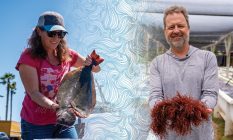
On a warm afternoon, Kim Selkoe ’97 stands on a dock at the Santa Barbara harbor waiting for a local fisherman. Dressed in jeans and a T-shirt, she has a baseball cap pulled low across her forehead to shield her face from the sun.
Selkoe is there to buy fresh halibut for the 350 or so customers in Los Angeles, Ventura and Santa Barbara counties who have signed up for Get Hooked, her local-catch-of-the-day seafood delivery subscription service. Morgan Castagnola, a fourth-generation fisherman, ambles up the dock and steps onto his boat. He and Selkoe exchange friendly banter as he tosses whole fish from the large receptacle on deck to a smaller tub nearby. He wheels the tub to the upper pier, where Selkoe’s pickup truck is parked. She hops onto the truck bed and transfers the halibut—50 pounds worth—to her cooler. She packs it all in ice, tamps down the lid and then completes the paperwork.
Thirty or so miles up the coast, Doug Bush ’94 moves easily among the rows and rows of fiberglass tanks that are the heart of his onshore shellfish farm. A thin layer of fog hangs over the canyon, and the damp dirt and gravel crunch beneath the weight of his heavy hiking boots. A partner in The Cultured Abalone Farm, Bush is raising the native Haliotis rufescens. Shaded from the elements and continuously refreshed with cool, clean saltwater from the Santa Barbara Channel, the tanks—400 in all—emulate the rock substrate of the abalone’s natural environment.
Bush and his team cultivate the mollusks—long prized as culinary delicacies—through their entire life cycle, harvesting live, market-size seafood, which the farm sells directly to restaurants or to home chefs and other abalone lovers via the farm’s online store. Selling upward of 35 tons of seafood per year, the abalone farm—one of only three in California—has tapped into an enthusiastic market. Upscale restaurants in Northern California such as Atelier Crenn, The French Laundry and SingleThread have featured the farm’s abalone on their menus, as do a few closer to home, including the famed San Ysidro Ranch, Lucky’s and Mattei’s Tavern. Occasionally, the delicacy is available to Selkoe’s Get Hooked customers.
Selkoe and Bush are making a splash in the sustainable fishery and seafood industries in Santa Barbara, but they have more in common than a shared passion for marine life. Both headed west for college—she from Massachusetts, he from Missouri—and both graduated from Pomona College with bachelor’s degrees in biology.
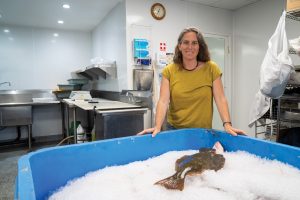
Kim Selkoe’97 displays some of the day’s catch. The seafood usually reaches her customers within two days of being caught. Photography by Jeff Hing
A native of Boston, Selkoe found her calling as a marine ecologist in California. “For as long as I can remember I’ve been fascinated by sea creatures and the diversity of the oceans,” she says. A family vacation on the West Coast included a road trip from San Francisco to Los Angeles, and she fell in love with the Golden State. “I knew I wanted to be a marine biologist and live in California,” she recalls, “and I became fixated on going to college there.”
Pomona College, with its strong biology program—and, by the way, springboard diving team—dominated Selkoe’s list of possibilities. The swimming pool, with its grand view of the mountains, was a major selling point. “It was really stunning for me, coming from Boston,” she recalls. “I thrived at Pomona, being able to pursue my passions of marine biology and springboard diving.”
One faculty member in particular, the late biologist Larry C. Oglesby, stands out to Selkoe for the impact he had on her as a student, as a researcher and, ultimately, as the leader of two large, complex organizations—Get Hooked and the nonprofit Commercial Fishermen of Santa Barbara, where Selkoe serves as executive director. “I developed a strong relationship with Professor Oglesby, and he really guided me,” she says. “In his classes, for example, he focused on synthesizing research—you have to choose five research papers on a topic and then write one paper that brings all of them together. And that’s exactly the kind of work I did in grad school and the work I do now.”
So, with a strong foundation in marine biology, Selkoe “hit the ground running” when she commenced her graduate studies at UC Santa Barbara (she completed her Ph.D. in marine ecology in 2007). “I really understood how science papers are written,” she says, “and how research gets distilled down into a paper and how that fuels the next generation of questions in science and pulls the field in different directions. And I learned that in my science classes at Pomona.”
Those skills became central to work Selkoe did as a postdoctoral researcher at the University of Hawaii at Manoa and as an independent researcher at UC Santa Barbara’s Marine Science Institute, where she continued her studies on the population genetics of kelp forest species. “We wanted to understand how much connectivity (immigration and emigration) there is between the different habitat areas—in this case, the kelp forests of Southern California and Baja Mexico,” she explains. “The question we were asking was, can you manage California and Mexico fisheries separately, or do you have to consider them as completely integrated and interdependent?”
The short answer: They are quite interconnected. “There is a little bit of a bias toward Southern California as a repository of fish from Mexico, so our fisheries here are much more impacted by what they do in Mexico than fisheries down there are impacted by what we do here,” Selkoe notes.
In reality, she adds, the globalized seafood industry makes everything interconnected.
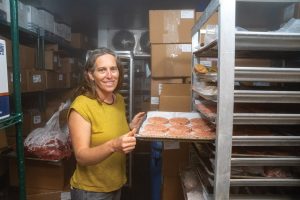
A Farm to School grant will help Selkoe and her team provide salmon patties like these to selected area schools. Photography by Jeff Hing
At the same time, Selkoe began a side project, the Santa Barbara Sustainable Seafood Restaurant Program, which sought to put sustainable seafood on the menus at local restaurants. “I ran the program for six or seven years, and I learned a lot,” she says.
When she crossed paths with Stephanie Mutz, a local sea urchin diver and then-president of the Commercial Fishermen of Santa Barbara, they put their heads together and began to look at how they could promote local seafood. They were familiar with the community-supported agriculture movement and how farms and even some fisheries were creating subscription programs. “So, we created a community-supported fishery program and called it Community Seafood. It was a great success.”
Meanwhile, Selkoe’s association with Commercial Fishermen of Santa Barbara continued. Mutz eventually moved on, a new president was named, and Selkoe became the organization’s executive director. Incorporated in 1971, Commercial Fishermen of Santa Barbara has a threefold mission: to provide healthy, high-quality seafood to local and global markets, to ensure the economic and biological sustainability of fisheries, and to maintain California’s fishing heritage. “As much as I love research, academic research paper writing was less interesting to me, and I wanted to get more involved full time in the fishing community,” Selkoe says.
Fast forward, and Community Seafood has been replaced with the more robust seafood subscription service Get Hooked, which Selkoe co-founded with Victoria Voss, a Santa Barbara native who also has strong ties to local fisheries. “We focus on buying direct from our fishermen and we focus on diversity, which allows people to taste all the different seafood available here,” she explains. “In a given year, we’ll have 40 different species of California-caught seafood.”
But Get Hooked does more than deliver fresh seafood to its subscription customers. With Selkoe at the helm, Get Hooked is growing and expanding its reach. “We started renting out our commercial kitchen to other fishermen. We started a wholesale program. We’re developing meal kits,” she says. “Our fish, with our Get Hooked label, is in grocery stores in the Bay Area.”
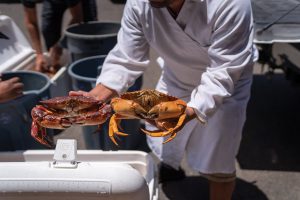
Rock crabs, are caught year-round. (The Dungeness crab season usually opens in late fall.) Photography by Jeff Hing
In addition, Selkoe and her team have partnered with local farms and garden centers to turn their fish scraps into soil amendment, and they are spearheading a pilot project—courtesy of a generous Farm to School grant—to develop kid-friendly fish burgers and fish sticks that they’ll bring to selected school districts in Ventura County.
“What I love is that the ecosystem is raising our food for us without the fossil fuel and land conversions you get with land meat and even vegetables,” Selkoe says. “There can be some habitat impacts when we fish, but they aren’t wholesale habitat destruction.
“The things we’re harvesting from the ocean are packed with nutrients in a way we can’t get on land,” she continues. “It’s a beautiful thing that we can have this wild harvest. And our planet is 70% ocean—it’s big enough to support us if we manage it properly. If we fish sustainably and harvest sustainably, we can meet the protein needs of large numbers of people on the planet. With Get Hooked, we’re giving people an option they can feel good about.”
That’s a philosophy Doug Bush can get behind, and a philosophy he brings to his abalone aquaculture.
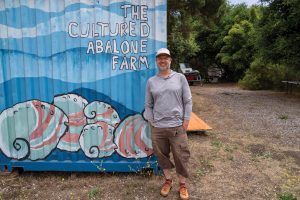
Doug Bush ‘94 is a partner and general manager of The Cultured Abalone Farm, one of only three abalone farms in California. Photography by Jeff Hing
“Nothing is zero impact,” he says. “It’s a matter of choosing what’s best, and that’s enormously complicated. But we can affect only what we do, and we do a really good job growing native California red abalone.”
A biologist with an interest in history and anthropology, Bush has a deep, personal connection not only to Dos Pueblos Canyon, the land along the Gaviota coast that is home to The Cultured Abalone Farm, but also to the way his work is intertwined with place and history. “Abalone is an iconic California seafood, but it goes way back,” he says. “It’s well known that the Chumash occupied this area but, in fact, there have been humans living not just in California but on the dirt where we’re standing for, according to some estimates, 14,000 years.”
Under Bush’s guidance, The Cultured Abalone Farm is committed to creating a sustainable regional food system. “Seaweed is a tremendous, underdeveloped resource for nutrient capture, carbon sequestration, unique nutritional compounds for both humans and animals, and forage for vegetarian marine invertebrates like abalone,” he explains.
The unique microbial community of the abalone digestive process converts seaweed into one of the most nutritionally complete sources of protein that can be found anywhere, Bush says. “This process is a natural subsidy, and our job at the farm is simply to try and harness it and manage it to create a food source in a repeatable way,” he continues.
The farm has a standing inventory of roughly 1 million abalone, ranging in size from 10 millimeters to market size, which, according to Bush, is “about the size of your palm.”
The abalone are raised in a land-based seawater tank system designed to accommodate them through each stage of development. In addition, Bush cultivates on-site the two types of red seaweed that comprise the abalone’s diet. “We also harvest giant kelp from the nearshore,” he says. “Kelp harvesting is among the most sustainable of all marine harvests. We harvest only 15 inches below the surface from the perennial kelp plant, which remains intact and continuously grows new fronds.”
While Bush, who has a master’s degree in animal science from UC Davis, grows red abalone exclusively for commercial production, he also is part of a group led by the UC Davis Bodega Marine Laboratory that seeks to restore the critically endangered white abalone.
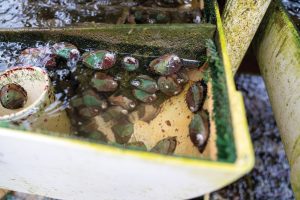
Red abalone, shown here, have been successfully farmed after overfishing and environmental factors devastated the ocean population. Photography by Jeff Hing
“We collaborate in the technical husbandry aspects of maturation and spawning of a small number of captive adult white abalone,” he says, “and then also participate in the group effort to successfully raise the larvae of a successful white abalone spawn into small, competent individuals that can be planted in offshore locations.” This is all in the hope of re-establishing a self-sustaining population of white abalone in the wild.
But how does a guy from the Midwest end up in California raising abalone? Quite simply, Bush says, it was the “enduring appeal of the Golden West.” Like Selkoe, when he began researching colleges and universities in California, he hit upon Pomona College. It was the right place.
“I loved my time at Pomona College,” he says. “I learned how to be a student, how to teach myself to learn. I’m not sure I would have done as well at that in a different environment. And I never felt like I was forced into some artificial exclusivity—like being on a biology track meant I wasn’t welcome to take art classes or history classes or literature classes. I was given the opportunity to be a whole human intellectually.”
Relationships with faculty members, including Oglesby and Bush’s freshman advisor, botanist Sherwin Carlquist, who died in 2021, inspired and motivated him. “Both were fundamental to my enjoyment of biology, and both encouraged me to apply that enjoyment in a way that was personally meaningful,” Bush says. “They taught me a lot about trusting myself, but also being accountable for my assumptions. For both, there was a certain joy in the subject matter of the natural world that really affected me.”
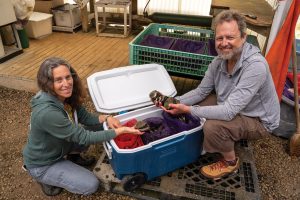
Selkoe and Bush didn’t know each other at Pomona but met at the Saturday Fishermen’s Market in Santa Barbara. Photography by Jeff Hing
After graduating, Bush joined the Peace Corps and taught biology to high school students in the East African nation of Malawi. “Near the school where I taught was a little agricultural development project site,” he says. “It was a fish farm with a couple of ponds, and I used to take my students over there to learn about nutrient cycling and food webs. The fish would get dried on tiny racks, and you’d see them in the local trading center market. And I remember being struck at the time that this is a local market-driven ability to provide a protein source in a community that is protein insecure.”
Returning from Malawi, Bush sought ways to pursue his new interest in aquaculture. A fellow Pomona College alumnus got him started. “I happened upon an article about David Leighton [’54], who had been raising abalone in a small lab in Carlsbad,” Bush says of the San Diego County biologist, who died in 2017. “I called him out of the blue and he invited me to come help out around the farm, which he shared with a small mussel-growing business and another few incubating farming ideas.” Bush jumped in, doing all manner of dirty, cold, wet work. He spent his days cleaning out filters; swimming rafts of bay shellfish between their lines; and building prototype cages, bags and specialty containment systems.
“I maintained a close relationship with David throughout my professional development,” Bush continues, “and he was a good friend to The Cultured Abalone Farm and a great resource once I landed here in Santa Barbara.”
And that’s a boon for Selkoe, whose post-college association with Bush began at the Saturday Fishermen’s Market at the Santa Barbara Harbor. One thing led to another, and they discovered their shared connection to Pomona College. Now they are also colleagues, and both together and separately are helping build out the future of sustainable fisheries and of a seafood industry that can feed the world as it supports the planet.



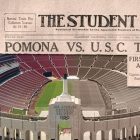

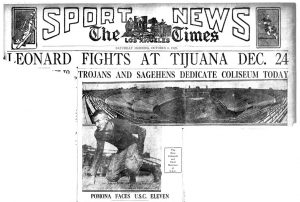
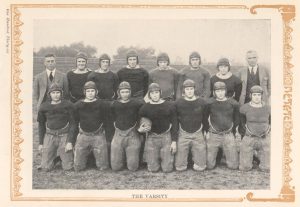
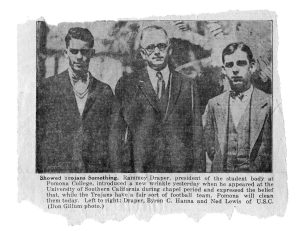

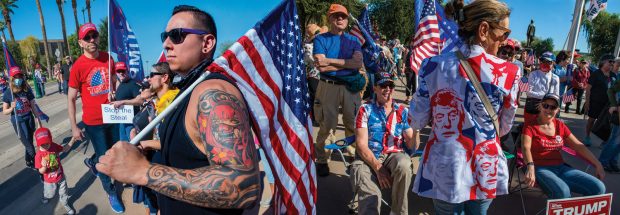


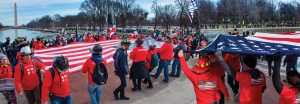

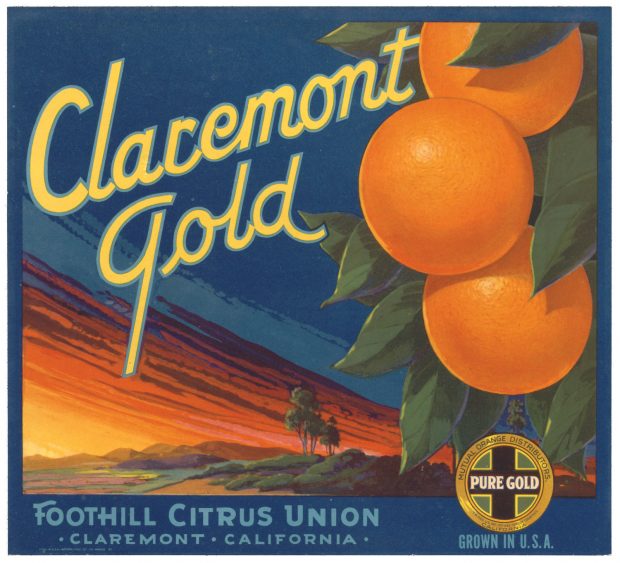
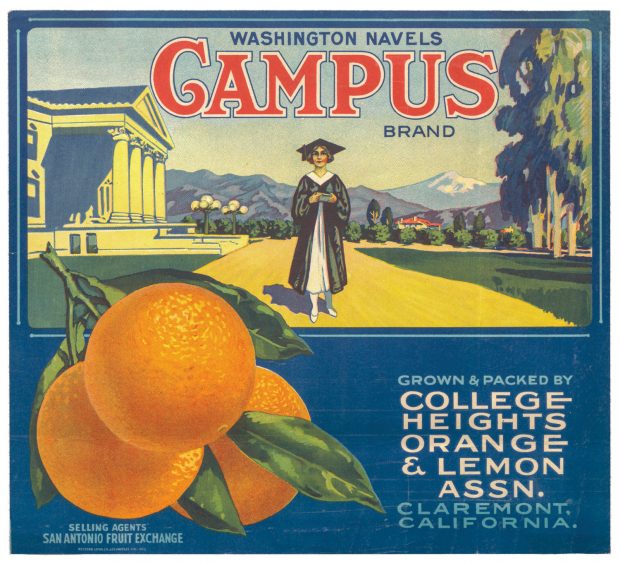


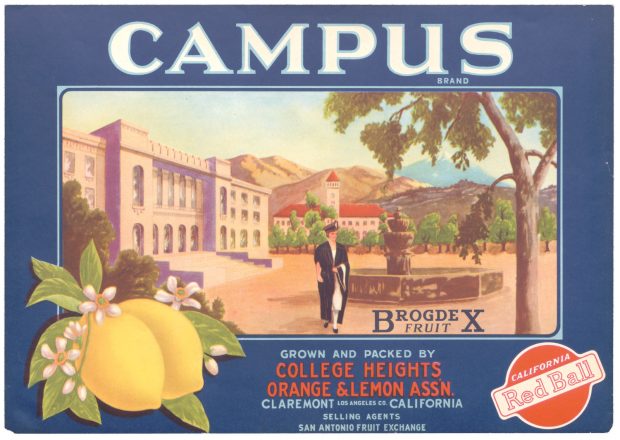
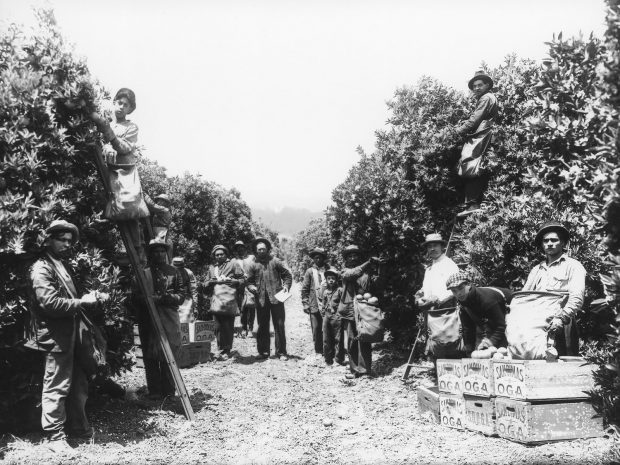
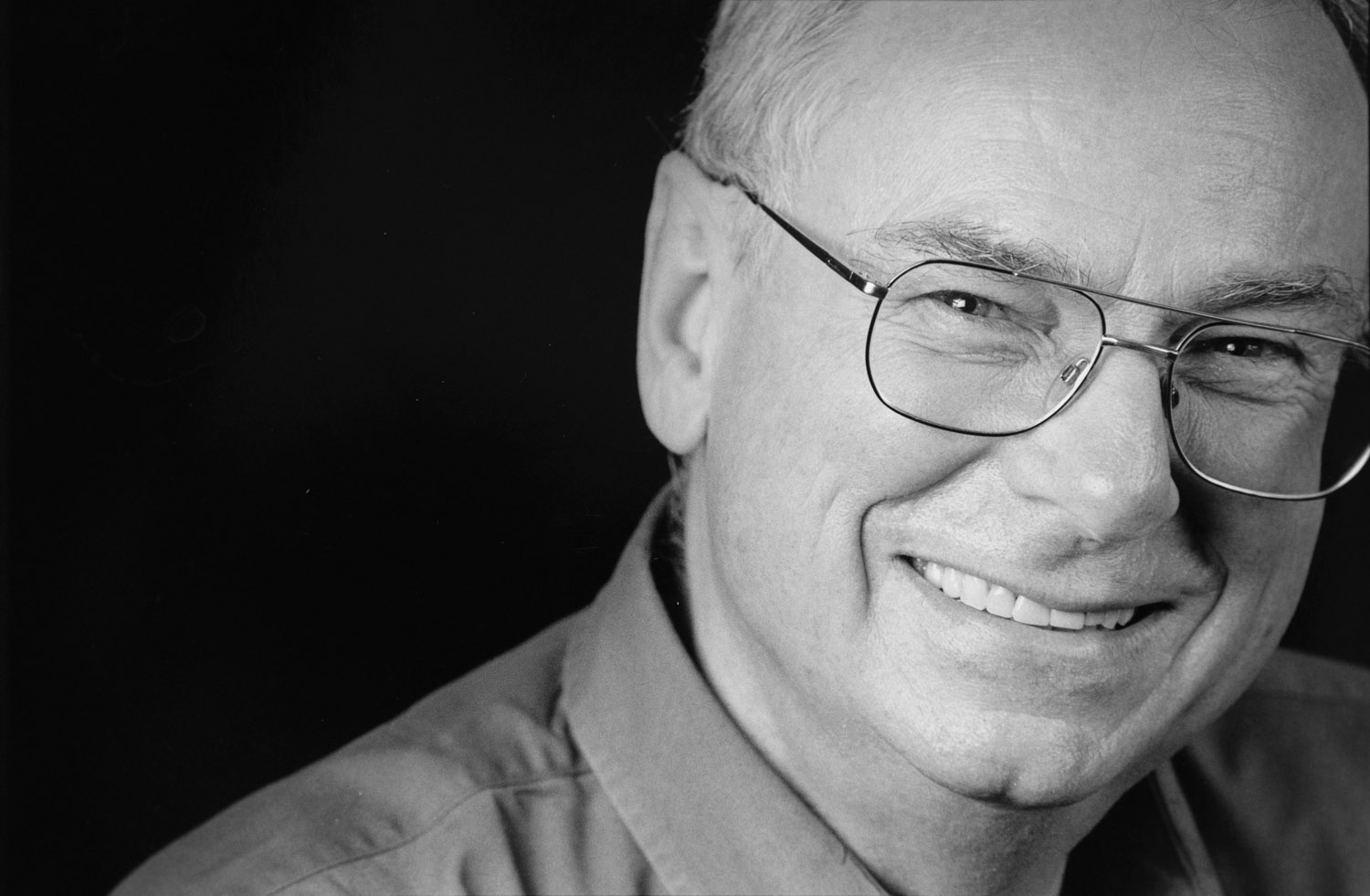
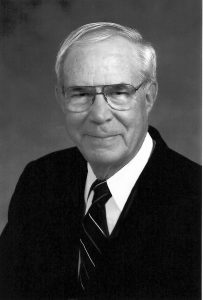
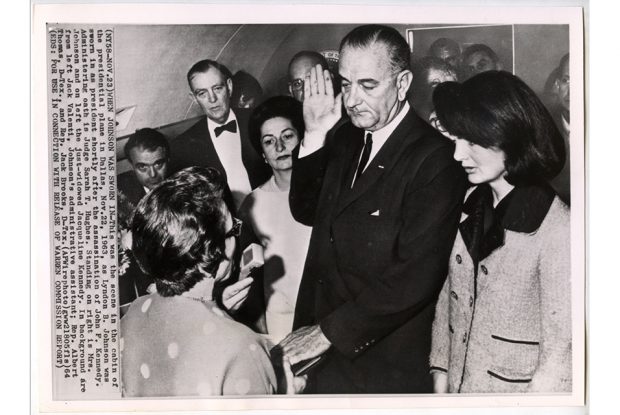 Inspired by Myrlie Evers-Williams ’68 and the gift of her archives to the College, Michael Mattis and Judy Hochberg have donated their collection of more than 1,600 press photographs documenting the civil rights movement to the Benton Museum of Art at Pomona College in her honor. The Mattis-Hochberg photos include scenes of resistance, acts of civil disobedience and images of civil rights leaders including Martin Luther King Jr., Cesar Chavez, James H. Meredith as well as photos of Evers-Williams.
Inspired by Myrlie Evers-Williams ’68 and the gift of her archives to the College, Michael Mattis and Judy Hochberg have donated their collection of more than 1,600 press photographs documenting the civil rights movement to the Benton Museum of Art at Pomona College in her honor. The Mattis-Hochberg photos include scenes of resistance, acts of civil disobedience and images of civil rights leaders including Martin Luther King Jr., Cesar Chavez, James H. Meredith as well as photos of Evers-Williams.